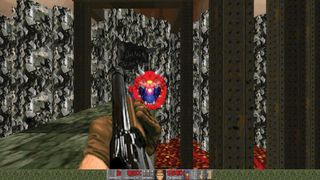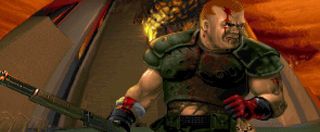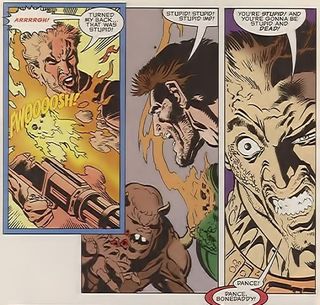Doom may be a classic, but were the novels?
We're rerunning Richard Cobbett's classic Crapshoot column, in which he rolled the dice and took a chance on obscure games—both good and bad.

From 2010 to 2014 Richard Cobbett wrote Crapshoot, a column about bringing random obscure games back into the light. And sometimes a good book. Well, a book. Well, a Doom novel. The surprising thing isn't that they wrote one. It's that they wrote four of the damned things...
When I think of deep in-game narrative, I think of Doom. The plot twists. The heartbreak. The comedy. The romance. In Doom, we had not merely gaming's Citizen Kane, but its Ulysses, its Plato, and its Lady Chatterley's Lover. Its levels were more than mere shooting galleries. They were metaphors for life itself, from Central Processing representing the doomed folly of seeking ultimate control, to the searing portrayal of nihilism versus optimism in the wittily named "Military Base". How could it not spawn a set of four novels? Only if it had spawned five, just to really explain its philosophical underpinnings and clarify its take on the quintessential existential crises in a world where the Devil exists and has a shotgun.
Truly, this may be the most underrated series in Western Literature. Or not.

As with a few other episodes, let's start with a quick disclaimer: I AM NOT MAKING THIS UP. Doom did in fact spawn four novels, plus the infamous comicbook, and there are a couple more based on Doom 3. Now, the fact there's a book isn't entirely surprising. Doom was huge after all, and sillier games than that have seen novelisations—arguably the silliest of them being the two Shadow Warrior novels about Lo Wang, Duke Nukem's racist cousin. How bad are they? They are this bad:
With a finger wagging at the man, he said, "No. No. No." It was as if he was scolding a misbehaving child. There was no point in letting the businessman be killed. He would someday have grandchildren who needed a story. And a hero. And the businessman needed to be alive to tell the story of the great Japanese restaurant shoot-out. Wang stood and turned to face the gunmen, knives in both hands.
"Who want some Wang?"
Most game novelisations absolutely stink, from Tiberium Wars (where the main character gets the nickname 'Puke' and things get worse from there) through to the truly godawful Baldur's Gate 2. Some are merely mediocre, like the Gabriel Knight books, which offer better writing but really just retell a story that you already know in a form that it wasn't intended to be enjoyed in. Very occasionally, some of them are good, like Under a Killing Moon, where the author got to put back lots of the story that was cut from the game, or a few of the Halo novels. Mostly though, they suck, and it's often not the author's fault. Generally the deadlines are tight, and much of the writing has to done before the game itself is locked down, without the author necessarily getting much/any chance to play it. It's the equivalent of writing about something you've only been told about over the telephone, which is why most (although not all) of the better received ones have tended to come from people who actually worked on or created the original game. They know, and presumably have a connection to the material, while a hired-pen simply has to take their best shot.
PC Gamer Newsletter
Sign up to get the best content of the week, and great gaming deals, as picked by the editors.
Against all this, you'd expect the first Doom novel to be a full-on black hole of pure, irredeemable suck. Guess what? It's not. It's not a great book. It's not even a good book. But it is a fun book, one written by authors who at least tried to do something with the material. What they did was take an all-out maze shooter and make it utterly insane , but never mind. Insanity can be fun. Just ask this guy:

Really, the first Doom novel is... pretty much... Doom. You can recognise many of the levels in the descriptions. The monsters are a bit different (for instance, the imps, called 'spinies', attack by spitting into their hands and throwing it at people rather than summoning fire out of nowhere), and to make things more science-fictiony, they're revealed to be aliens pretending to be demons to score a psychological advantage, but these are relatively small tweaks. Certainly, the official movie based on Doom 3 changed things a hell of a lot more. The basic premise is even the same, with the Doomguy—given the name Flynn "Fly" Taggart—arrested for assaulting a superior officer who planned to mow down civilians, and being left alone to fend for himself when the aliens/demons attack Phobos via their interdimensional gate to Hell/Oh Just Wait.
(If you have no idea what I'm talking about here, it was all in the Readme file. While it has no bearing on the actual game that we got, Doom was originally intended to be much more story-driven than you'd think, set on a planet called Tei Tenga rather than Mars, with set-pieces like finding fellow soldiers dead at a poker table. Almost all of it got stripped out during development, for better or worse.)
The main difference is that Fly is... adaptable. And a little bit unusual, with a hilariously goofy internal monologue considering that he's based on a completely silent protagonist. Here, do a test. Here's a picture of the Doomguy, and a scrap of Fly's narration. Imagine these words coming from this guy.

Now we had a moment to enjoy the new decor. The motif here was gleaming chrome and intricate, blued enamel. The appearance was rather sci-fi, actually... utterly misplaced, considering the monsters inhabiting it. But then, I didn't subscribe to Better Homes and Demons.
You know that point in most survival horror games, when you've seen it all? When you start running backwards, because you know that if you go straight forwards, a monster closet is going to open up behind you? That bit where the same monster leaps out for the fiftieth time, but it doesn't matter because you've got a shotgun? That's Fly, a man who spends a few chapters in a mad panic, mostly fretting about a fellow marine called Arlene and the fact that he's surrounded by zombies, then quickly comes to the conclusion that as grim as the situation is, it could be worse. For the first half of the book, he's pretty much alone, just going from encounter to encounter, killing zombies who smell of citrus and constantly referring to himself as "Yours Truly". A few of the zombies talk back, saying generic creepy things, and one of them even compliments him on being stronger than they expected, but there's not really much plot until he finally tracks Arlene down and the two team up for the second half of the book.
(Incidentally, a note on Arlene: You may have heard this name in connection with Doom before, although she isn't in any of the games. Years after the books came out, it was what the Columbine murderer Eric Harris called his prized sawed-off shotgun—supposedly, but not definitely, named after her.)
Once Fly and Arlene are together, the book completely changes, even trying its hand at a bit of comedy. Fly tracks her down by following Jules Verne style marks (a gimmick that writer Dafydd ab Hugh later re-used in a Deep Space Nine novel called Fallen Heroes, and by god, do I feel like a geek for knowing that) to an apparently Skynet-designed teleporter that slings him to Deimos stark naked. He's initially more concerned about losing his gun than his dignity, since as far as he knows he's the only non-zombie human for several million miles. Obviously then, it takes roughly five seconds before Arlene shows up.
"You're alive!" I shouted.
"No, really?" she shouted back.
We slowly lowered our weapons simultaneously, mirror images of each other. Grinning.
Staring me up and down, she commented, "Nice fashion statement." I'd forgotten I was buck naked. My damned reflexes insisted on embarrassing me, and I reflexively covered myself. Well, I guess it was one more proof I was still fully human. I doubt that zombies are modest.
"Turn your back, for Christ's sake," I implored.
"I will not" she answered, eyes roving where they shouldn't. "You're the first decent thing I've seen since this creep show began."
If we kept this up, maybe things would get so bloody normal that the monsters would simply pack their suitcases and leave.
They quickly get dressed by stripping a couple of corpses (oddly, Fly seems to get dressed by putting his boots on first, showing that even a futuristic marine who's strong enough to impress alien monsters, cutured enough to recognise Jules Verne references, scientific enough to discuss the gravitational differences between Phobos and Earth, and historically versed enough to know who The Addams Family are... can be outmanouevered by his own trousers. So there's hope for the rest of us mortals.)
Once together, the book becomes much more fun—switching from full monologue to an almost constant back and forth. Fly and Arlene have a good relationship—friends, colleagues in arms, and mutually-agreed unrequited crushes—who are well enough trained not to just scream at the monsters, but try to defuse them a bit. For instance, they quickly start up a game about naming the monsters. Cacodemons become 'pumpkins', Demons become pinkies, and Imps/Spinies... they cause arguments.
I pointed at the brown carcass of a spiny.
"So if you don't want me calling it a demon," I said, "how about a spiny?"
"How about an imp?"
"An imp?"
"Why not? I had a book of fairy tales when I was a kid with goblins and things. The picture closest to this critter had the caption 'imp.' It was playing with magical fire."
Our game was becoming fun. We didn't have a lot of entertainment at the moment. "I dunno," I said. "Some- thing about the head reminds me of an old monster movie about a fish-guy who lived in a lagoon."
"He's an imp," she insisted, reminding me that tough Marine or not, she was still a woman.
My mother didn't raise any fools. "He's an imp," I agreed.
They also quickly start a discussion about just what the hell—literally—is going on after encountering a room reshaped to look like a swastika, leading to the conclusion that the invaders might not be the organised, elite force they seemed, but just a bunch of chancers. They quickly stop being impressed by all the skulls and flesh everywhere, often to the point of outright mocking or deconstructing it with a sigh. After a while, it gets so silly they start openly expecting their former allies to start jumping out in devil suits, and complaining that if the monsters are being ripped from their imagination, they're embarrassed for having such corny fears. The final humiliation for the aliens is when Fly and Arlene start talking about roasting marshmallows on the hellfire, and making innuendos about a statue with a giant erect penis probably being a switch. It is, indeed, a switch. ("I've handled worse," admits Arlene, pulling it.)
"She could sound like a professor when she wanted to: "Maybe the demons - the aliens -were confused by Hollywood into thinking the swastika is a satanic symbol. It sure seems suspiciously like somebody had an official list of Things that Scare Westerners... like they knew it would be seen by UAC workers and Marines, not by Native American Indians or Japanese. Wonder if they'd change the symbols for different humans, say using the letters kyo or oni if they were invading the Nippon Electric space station?"
The rest of the story is much what you'd expect. There's no Hell, but Fly and Arlene keep fighting their way through Deimos, finally defeating the Spider Mastermind and realising that Deimos has been retrofitted to be a moon-sized space-ship, preparing for an invasion of Earth. The book ends with them still trapped there, but with Arlene coming up with a plan to get back home. They do. Then things get weird.

Remember, all this has been one book. The first book of four . The second book, Hell on Earth, picks up the story with Fly and Arlene's return, where they land near Salt Lake City and discover that the Mormons are effectively leading the counter-strike against the alien invaders. Yes, really. Most of the existing world governments have either keeled over or turned traitor, with the worst of them being the IRS—yes, the American Internal Revenue Service—which apparently has its own military strike force called the Special Revenue Collection Division. This includes an infantry division, submarine, heavy bomber wing and a carrier battle group. So make sure you pay your taxes. And no, we're not to the silly stuff yet.
New characters include a 14-year-old computer hacker called Jill, and a Mormon called Albert who Arlene falls in love with despite hating his church with a fiery passion that burns with the heat of many suns. The Doom 2 monsters also get their turn to be named. For instance, the chaingunner marine is now:
"Clyde?" I asked, dumbfounded. "That's worse than Fatty! It's just a name."
"Clyde," she declared, with the really irritating tone of voice she only uses when she makes up her mind and can't believe anybody would still be arguing.
"But Clyde?" I repeated like a demented parrot. "Why not Fred or Barney, or Ralph or Norton?" I suspected that I might be spinning out of control.
"For Clyde Barrow," she explained . . . and I still didn't get it. "You know," she continued with the cultural-literacy tone of vice, "Bonnie Parker and Clyde Barrow--Bonnie and Clyde!"
"Oh," I said, finally ready to surrender. "Jesus H. that's really obscure!"
But still, that's nothing. Not when you discover that the aliens are called...
...wait for it...
Fred.
Yes. The Freds. From Fredworld. It's only a military designation, but that doesn't matter. In the history of humanity, the most dangerous, insidious threat ever faced by mankind was called Fred. And the books aren't even close to being finished. By the third, Infernal Sky, in which Salt Lake City gets destroyed, a new alien race shows up to help. They're called the Klave, a race of aliens who get two bodies per person. They don't really understand names, so they pick two via telepathy, leading to their ambassadors to humanity being named Sears and Roebuck. They also explain that humanity is the only truly mortal race they've encountered, with everyone else getting to live on as ghosts and be revived. It turns out that the whole Doom situation is merely a scrap of a tiny, intergalactic war. Oh, and there's another race called the Newbies, who evolve so fast that they're actually defeated by being evolved into nothingness, are actually allergic to faith (not necessarily in anything in particular, just the concept).
If you're not confused enough yet, all these factions are locked in a universe-scale war between two groups called the Hyperrealists and the Deconstructionists—something that makes such little sense that it's basically explained outside of the book itself. Here's the snippet:
I handed (the book) to her. The title was: The Deconstructionists' New Clothes, Being the Oh-So-Secret History of the Galaxy's Most Stupidest War. The author was Jill Lovelace, PhD, LLD, CIA, MAD. It was a short story, but we both realized what it really was. Somehow, Jill had managed to pry out of someone, maybe the Klave - Sears and Roebuck's uncles? - the whole freaking mystery that we never could get... what the damned war was all about! Yeah, right, the Six Million Year War that resulted, eventually, in a strategic chess move by the Freds, of House Deconstructionists, to invade Earth and kill us by the millions. The war that had started the whole thing.
I'm not going to quote the whole story. It was long and pretty damned good, and I don't want Jill's electrifying prose to make my own look lamer than it already does. So I'll paraphrase the intel instead. Of all the secrets Arlene and I had faced since we first found ourselves under attack by space demons, that was the most frustrating, the most galling... or to Arlene, the outright funniest: that a war could erupt and be prosecuted for six million years between two competing schools of literary criticism!
Just to clarify, yes, this is indeed a story based on this:

It's barely even worth mentioning that by the end of the story, Fly is trapped in the Matrix. There is one nice touch though, in the explanation for the Freds' invasion is that they took their notes back in the Middle Ages, hence the whole 'Hell' look, but with space travel taking so long and humanity 'evolving' faster than they expected, they didn't really plan on getting back to find moonbases, atheists and plasma guns ready to meet their army. If you want to see the whole sweep of the plot, check the Doom Wiki for a full synopsis.
If you're interested in reading the Doom books, unlike most game novelisations, they're actually still pretty easy to get hold of. The first one is the only one genuinely worth bothering with for the laughs, since as you can see, the others wasted as little time as possible on Doom before heading off to do a completely unrelated sci-fi story that's only really worth the time it takes to pick your jaw up off the table and finish saying "What the fu-" a few times. Still, they could definitely have been worse. Shudder.
Most Popular


